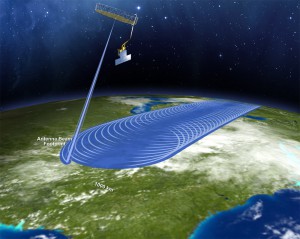How SMAP Works
 SMAP will produce accurate, high-resolution results through the combined efforts of its two instruments, a radar and a radiometer. The radar emits a signal, then measures the backscatter that bounces back from Earth. The radiometer, on the other hand, simply records the microwave signal our planet naturally emits. “Active Passive” in the mission’s name refers to these two instruments: one active, one passive.
SMAP will produce accurate, high-resolution results through the combined efforts of its two instruments, a radar and a radiometer. The radar emits a signal, then measures the backscatter that bounces back from Earth. The radiometer, on the other hand, simply records the microwave signal our planet naturally emits. “Active Passive” in the mission’s name refers to these two instruments: one active, one passive.
The observatory will sweep above Earth in a near-polar orbit at an altitude of 426 miles. Its 19.7-foot-wide, rotating antenna will allow the spacecraft to observe a 620-mile-wide swath. This means SMAP will be able to map the planet’s equatorial regions every three days, and the higher latitudes every two days.
NASA’s Jet Propulsion Laboratory in Pasadena, California, built the spacecraft and is responsible for the radar instrument, mission operations and other functions. The agency’s Goddard Space Flight Center in Greenbelt, Maryland, is responsible for the radiometer. Launch operations are managed by the NASA Launch Services Program, headquartered at Kennedy Space Center in Florida.




























